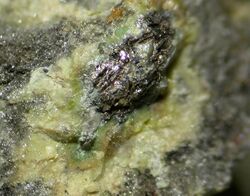Chemistry:Sillénite
| Sillénite | |
|---|---|
 Sillénite from Germany | |
| General | |
| Category | Oxide mineral |
| Formula (repeating unit) | Bi12SiO20 |
| Strunz classification | 4.CB.70 |
| Dana classification | 16a.03.05.01 |
| Crystal system | Cubic |
| Crystal class | Tetartoidal (23) H-M symbol: (23) |
| Space group | I23 |
| Unit cell | a = 10.110 Å, Z = 2 |
| Identification | |
| Color | Olive-green, gray-green, yellow-green, yellow, reddish-brown |
| Crystal habit | Cubic crystals |
| Mohs scale hardness | 1–2 |
| |re|er}} | Adamantine |
| Diaphaneity | Translucent |
| Specific gravity | 9.16 |
| Optical properties | Isotropic |
| Refractive index | >2.5 |
| Birefringence | none |
| Solubility | Soluble in hydrochloric acid |
| References | [1][2][3] |
Sillénite or sillenite is a mineral with the chemical formula Bi12SiO20. It is named after the Swedish chemist Lars Gunnar Sillén, who mostly studied bismuth-oxygen compounds. It is found in Australia, Europe, China, Japan, Mexico and Mozambique, typically in association with bismutite.[1][2][3]
Sillenites refer to a class of bismuth compounds with a structure similar to Bi12SiO20, whose parent structure is γ-Bi2O3, a meta-stable form of bismuth oxide.[5] The cubic crystal sillenite structure is shared by several synthetic materials including bismuth titanate and bismuth germanate.[6] These compounds have been extensively investigated for their non-linear optical properties.[7][8][9]
Additional stoichiometries, and modified structures, are also found in Bi25GaO39, Bi25FeO39, and Bi25InO39.[10][11] These compounds have gathered recent interest due to their photocatalytic properties.[12]
Recently, sillenites have also gathered interest as heavy metal glass ceramics. They are considered promising materials for laser technology as they combine strong nonlinear properties, relative ease of manufacturing, and low production cost.[13][14]
References
- ↑ 1.0 1.1 Sillenite. Webmineral
- ↑ 2.0 2.1 Sillenite. Mindat
- ↑ 3.0 3.1 "Sillenite". Handbook of Mineralogy. II (Silica, Silicates). Chantilly, VA, US: Mineralogical Society of America. 1995. ISBN 978-0962209710. http://www.handbookofmineralogy.org/pdfs/sillenite.pdf.
- ↑ Warr, L.N. (2021). "IMA–CNMNC approved mineral symbols". Mineralogical Magazine 85 (3): 291–320. doi:10.1180/mgm.2021.43. Bibcode: 2021MinM...85..291W.
- ↑ Valant, Matjaz, and Danilo Suvorov. "A stoichiometric model for sillenites." Chemistry of materials 14.8 (2002): 3471-3476 | https://pubs.acs.org/doi/abs/10.1021/cm021173l
- ↑ Santos, D. J.; Barbosa, L. B.; Silva, R. S.; MacEdo, Z. S. (2013). "Fabrication and Electrical Characterization of Translucent Bi12TiiO20 Ceramics". Advances in Condensed Matter Physics 2013: 1–7. doi:10.1155/2013/536754.
- ↑ Marinova, Vera, et al. "Real-time holography in ruthenium-doped bismuth sillenite crystals at 1064 nm." Optics letters 36.11 (2011): 1981-1983. | https://doi.org/10.1364/NP.2010.NTuC12
- ↑ Reyher, H-J., U. Hellwig, and O. Thiemann. "Optically detected magnetic resonance of the bismuth-on-metal-site intrinsic defect in photorefractive sillenite crystals." Physical Review B 47.10 (1993): 5638.
- ↑ Malinovskii, Valerii K., et al. "Photoinduced phenomena in sillenites." Novosibirsk Izdatel Nauka (1990).
- ↑ Scurti, Craig A., et al. "Electron diffraction study of the sillenites Bi12SiO20, Bi25FeO39 and Bi25InO39: Evidence of short-range ordering of oxygen-vacancies in the trivalent sillenites." AIP Advances 4.8 (2014): 087125. | https://doi.org/10.1063/1.4893341
- ↑ Arenas, D. J., et al. "Raman spectroscopy evidence of inhomogeneous disorder in the bismuth-oxygen framework of Bi 25 InO 39 and other sillenites." Physical Review B 86.14 (2012): 144116. | https://doi.org/10.1103/PhysRevB.86.144116
- ↑ Lopes, Armandina ML, João P. Araújo, and Stanislav Ferdov. "Room temperature synthesis of Bi 25 FeO 39 and hydrothermal kinetic relations between sillenite-and distorted perovskite-type bismuth ferrites." Dalton Transactions 43.48 (2014): 18010-18016.https://doi.org/10.1039/C4DT01825G
- ↑ Rejisha, S. R., et al. "Synthesis and characterization of strontium and barium bismuth borate glass-ceramics." Journal of Non-Crystalline Solids 388 (2014): 68-74. || https://doi.org/10.1016/j.jnoncrysol.2014.01.037
- ↑ Valant, Matjaz, and Danilo Suvorov. "Processing and dielectric properties of sillenite compounds Bi12MO20− δ (M= Si, Ge, Ti, Pb, Mn, B1/2P1/2)." Journal of the American Ceramic Society 84.12 (2001): 2900-2904.https://doi.org/10.1111/j.1151-2916.2001.tb01112.x
 |

